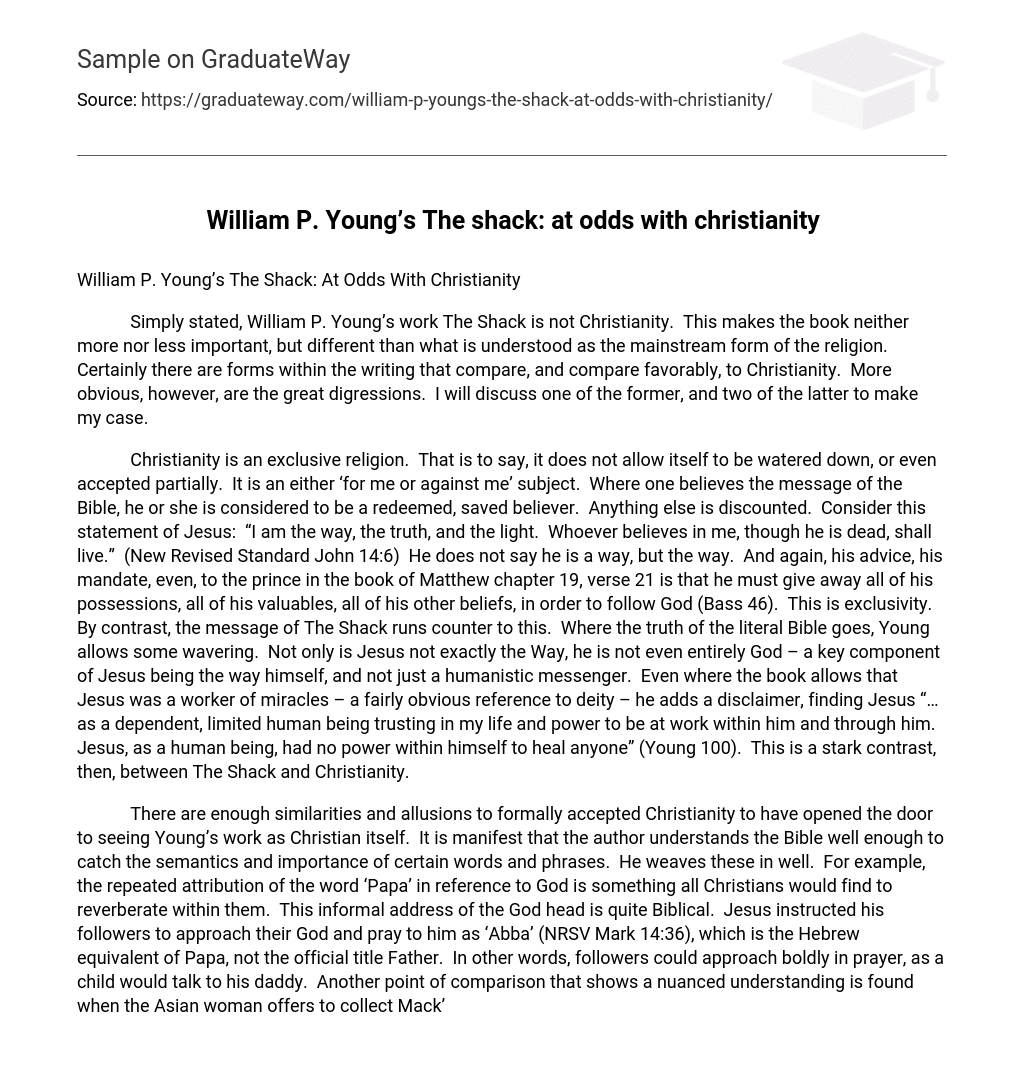Simply stated, William P. Young’s work The Shack is not Christianity. This makes the book neither more nor less important, but different than what is understood as the mainstream form of the religion. Certainly there are forms within the writing that compare, and compare favorably, to Christianity. More obvious, however, are the great digressions. I will discuss one of the former, and two of the latter to make my case.
Christianity is an exclusive religion. That is to say, it does not allow itself to be watered down, or even accepted partially. It is an either ‘for me or against me’ subject. Where one believes the message of the Bible, he or she is considered to be a redeemed, saved believer. Anything else is discounted. Consider this statement of Jesus: “I am the way, the truth, and the light. Whoever believes in me, though he is dead, shall live.” (New Revised Standard John 14:6) He does not say he is a way, but the way. And again, his advice, his mandate, even, to the prince in the book of Matthew chapter 19, verse 21 is that he must give away all of his possessions, all of his valuables, all of his other beliefs, in order to follow God (Bass 46). This is exclusivity. By contrast, the message of The Shack runs counter to this. Where the truth of the literal Bible goes, Young allows some wavering. Not only is Jesus not exactly the Way, he is not even entirely God – a key component of Jesus being the way himself, and not just a humanistic messenger. Even where the book allows that Jesus was a worker of miracles – a fairly obvious reference to deity – he adds a disclaimer, finding Jesus “…as a dependent, limited human being trusting in my life and power to be at work within him and through him. Jesus, as a human being, had no power within himself to heal anyone” (Young 100). This is a stark contrast, then, between The Shack and Christianity.
There are enough similarities and allusions to formally accepted Christianity to have opened the door to seeing Young’s work as Christian itself. It is manifest that the author understands the Bible well enough to catch the semantics and importance of certain words and phrases. He weaves these in well. For example, the repeated attribution of the word ‘Papa’ in reference to God is something all Christians would find to reverberate within them. This informal address of the God head is quite Biblical. Jesus instructed his followers to approach their God and pray to him as ‘Abba’ (NRSV Mark 14:36), which is the Hebrew equivalent of Papa, not the official title Father. In other words, followers could approach boldly in prayer, as a child would talk to his daddy. Another point of comparison that shows a nuanced understanding is found when the Asian woman offers to collect Mack’s tears (Young 84). What seems to be a nice and loving gesture is also a direct reference to the God of the Bible holding all of our tears in his hand (NRSV Psalm 56:9). There even exists within the text much more obvious Biblical allegories, chief among them the nature of the sacrifice that saved the Multnomah tribe (Lemons). These connections make it easy to quickly proclaim The Shack to be a Christian book, to compare, rather than to contrast.
To return to differences one more time, though, we readers see just as nuanced understandings of non Christian thought. Why would Jesus not be anything but the strongest human believer in God? Why would his strong belief alone be the tool with which he worked wonders? Because human philosophy cannot accept that the Perfect and Divine can live on earth which occupies real time and space. This was Plato’s and Aristotle’s agreement and still lives on today in a world so depraved that we cannot but expect that a perfect God is not actually around the corner (Vardy 21). This seems to be the gist of the book. According to the God of The Shack, Jesus did come to earth. Jesus did accomplish miracles. But Jesus, as I referenced above, could not have done so as God on earth. Here is one of the main points of contention between Christians and their acceptance of Young’s book.
Even in a constrained space such as the compare and contrast essay, it becomes easy to see that more, and more important, differences exist than similarities. Due to the highly exclusive nature of Christianity as put forth in the Bible, dissimilarities equal contrasts. Nitpicking small items of comparison is not enough to overwhelm the contrasting nature of William P. Young’s work, The Shack.
Works Cited
Bass, Diana B. A People’s History of Christianity: The Other Side of the Story. New York:
Harper One. 2009.
Lemons, Derrick. “Sacred Ritual.” Athens, GA. 15 Sept. 2009. Lecture.
New Revised Standard Version of the Bible. Division of Christian Education of the National
Council of Churches of Christ in the U.S.A. 1989.
Vardy, Peter, and Julie Arliss. The Thinker’s Guide to God. Hants, U.K.: John Hunt
Publishing. 2003.
Young, William P. The Shack. Newbury Park, CA: Windblown Media. 2007.





